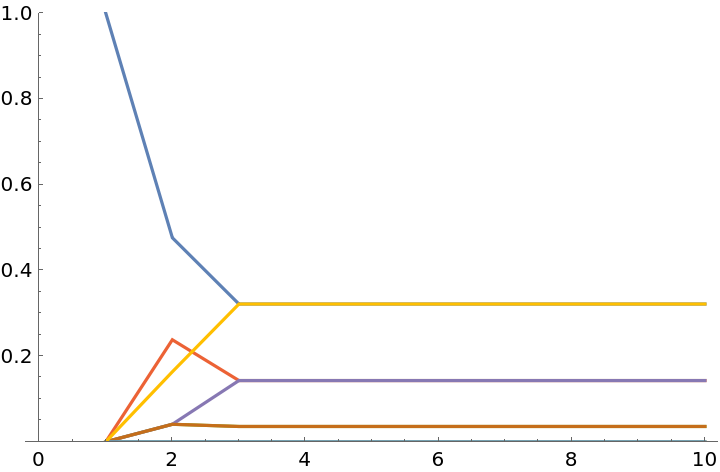Wolfram Function Repository
Instant-use add-on functions for the Wolfram Language
Function Repository Resource:
A quantum cellular automaton model that evolves the tensor product of a collection of initial qubits using arbitrary compositions of unitary operators for a finite number of steps
ResourceFunction["QuantumTensorAutomaton"][matrices,initial,t] evolves initial for t steps using a composition of unitary matrices given by matrices. |


Define a "CNOT" operator:
| In[1]:= | ![CNOTOperator = SparseArray[{i_, j_} :> If[(IntegerDigits[j - 1, 2, 2] == {IntegerDigits[i - 1, 2, 2][[1]], Mod[-Total@IntegerDigits[i - 1, 2, 2], 2]}), 1, 0], {4, 4}];](https://www.wolframcloud.com/obj/resourcesystem/images/794/79492958-1ac4-462c-b3c0-cde45395c174/7838612b9d1b03e1.png) |
Apply the operator "CNOT" 10 times to an initial state:
| In[2]:= |
| Out[2]= |  |
Visualize the state vectors for the preceding:
| In[3]:= |
| Out[3]= |  |
Compute the probabilities (norms squared) for the preceding:
| In[4]:= |
| Out[4]= |  |
Plot the probabilities (norms squared) against the steps (time) for the preceding:
| In[5]:= |
| Out[5]= |  |
Define and compose multiple operators:
| In[6]:= | ![rootNOTOperator = MatrixPower[SparseArray[{{1, 2} -> 1, {2, 1} -> 1}], 1/2];
fourierOperator = SparseArray[({i_, j_} :> Exp[2*Pi*I*Mod[(i - 1)*(j - 1), 4]/4]/Sqrt[4]), {4, 4}];
ResourceFunction[
"QuantumTensorAutomaton"][{rootNOTOperator, fourierOperator}, initialState[3], 10, "ColourPlot" -> True]](https://www.wolframcloud.com/obj/resourcesystem/images/794/79492958-1ac4-462c-b3c0-cde45395c174/544fece51c1e55f0.png) |
| Out[6]= |  |
Random unitary operators will also work:
| In[7]:= | ![randomUnitaryOperator := Module[{randomReal, randomComplex},
randomReal := RandomReal[NormalDistribution[0, 1]];
randomComplex := randomReal + I*randomReal;
Orthogonalize[Table[randomComplex, 4, 4]]];
ResourceFunction["QuantumTensorAutomaton"][{randomUnitaryOperator}, initialState[4], 20, "ColourPlot" -> True]](https://www.wolframcloud.com/obj/resourcesystem/images/794/79492958-1ac4-462c-b3c0-cde45395c174/176a97e48afd93c1.png) |
| Out[7]= |  |
This work is licensed under a Creative Commons Attribution 4.0 International License